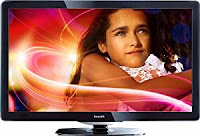
PHILIPS 32PFL3606 - 40PFL3606 - SERVICE MODE & LED BLINKING CODES - LCD TV
SERVICE MODEService Alignment Mode (SAM)
Press the following key sequence on the remote control transmitter: “062596” directly followed by the INFO[i+] /OK button. Do not allow the display to time out between entries while keying the sequence.
After entering SAM, the following items are displayed, with “SAM” in the upper right corner of the screen to indicate that the television is in Service Alignment Mode.
How to Navigate.
In the SAM menu, select menu items with the UP/DOWN keys on the remote control transmitter. The selected item will be indicated. When not all menu items fit on the screen,
use the UP/DOWN keys to display the next / previous menu items.
With the LEFT/RIGHT keys, it is possible to:
Activate the selected menu item.
Change the value of the selected menu item.
Activate the selected sub menu.
When you press the MENU button twice while in top level SAM, the set will switch to the normal user menu (with the SAM mode still active in the background). To return to the SAM menu press the MENU button.
The “INFO[i+]/OK” key from the user remote will toggle the OSD “on/off” with “SAM” OSD remaining always “on”.
Press the following key sequence on the remote control transmitter: “062596” directly followed by the MENUbutton to switch to SDM (do not allow the display to time out between entries while keying the sequence)
How to Store SAM Settings
To store the settings changed in SAM mode (except the OPTIONS and RGB ALIGN settings), leave the top level SAM menu by using the POWER button on the remote control transmitter or the television set. The mentioned exceptions must be stored separately via the STORE button.
How to Exit
Switch the set to STANDBY by pressing the mains button on the remote control transmitter or the television set, or by keying-in the “00” sequence on a standard RC-transmitter.
Note: When the TV is switched “off” by a power interrupt while in SAM, the TV will show up in “normal operation mode” as soon as the power is supplied again. The error buffer will
not be cleared.
In case the set is in Factory mode by accident (with “F” displayed on screen), pressing and holding “VOL-“ button for 5 seconds and then followed by pressing and holding the “CH-” button for another 5 seconds should exit the Factory mode.
Error Codes
Error codes are required to indicate failures in the TV set. In principle a unique error code is available for every:
Activated (SW) protection.
Failing I2C device.
General I2C error.
The last five errors, stored in the NVM, are shown in the Service menu’s. This is called the error buffer. The error code buffer contains all errors detected since the last time the buffer was erased. The buffer is written from left to right. When an error occurs that is not yet in the error code buffer, it is displayed at the left side and all other errors shift one position to the right. An error will be added to the buffer if this error differs from any error in the buffer. The last found error is displayed on the left. An error with a designated error code everleads to a deadlock situation. It must always be diagnosable (e.g. error buffer via OSD or blinking LED or via ComPair). In case a failure identified by an error code automatically results in other error codes (cause and effect), only the error code of the MAIN failure is displayed.
How to Read the Error Buffer
On screen via the SAM/SDM/CSM (if you have a picture).
Example:
> ERROR: 0 0 0 0 0: No errors detected
> ERROR: 6 0 0 0 0: Error code 6 is the last and only detected error
> ERROR: 9 6 0 0 0: Error code 6 was detected first and error code 9 is the last detected (newest) error
> Via the blinking LED procedure (when you have no picture)
How to Clear the Error Buffer.
The error code buffer is cleared in the following cases:
> By using the CLEAR command in the SAM menu:
> By using the following key sequence on the remote control transmitter: “062599” directly followed by the OKbutton.
>If the contents of the error buffer have not changed for 50 hours, the error buffer resets automatically.
Note: If you exit SAM by disconnecting the mains from the television set, the error buffer is not reset.
The Blinking LED Procedure
The software is capable of identifying different kinds of errors. Because it is possible that more than one error can occur over time, an error buffer is available, which is capable of storing the last five errors that occurred. This is useful if the OSD is not working properly.
Errors can also be displayed by the blinking LED procedure. The method is to repeatedly let the front LED pulse with as many pulses as the error code number, followed by a period of
1.5 seconds in which the LED is “off”. Then this sequence is repeated.
Example (1): error code 4 will result in four times the sequence LED “on” for 0.25 seconds / LED “off” for 0.25 seconds. After this sequence, the LED will be “off” for 1.5 seconds. Any RC
command terminates the sequence. Error code LED blinking is in red color.
Example (2): the content of the error buffer is “129600” After entering SDM, the following occurs:
1 long blink of 5 seconds to start the sequence,
12 short blinks followed by a pause of 1.5 seconds,
9 short blinks followed by a pause of 1.5 seconds,
6 short blinks followed by a pause of 1.5 seconds,
1 long blink of 1.5 seconds to finish the sequence,
The sequence starts again with 12 short blinks.
Additionally, the entire error buffer is displayed when Service Mode “SDM” is entered.
